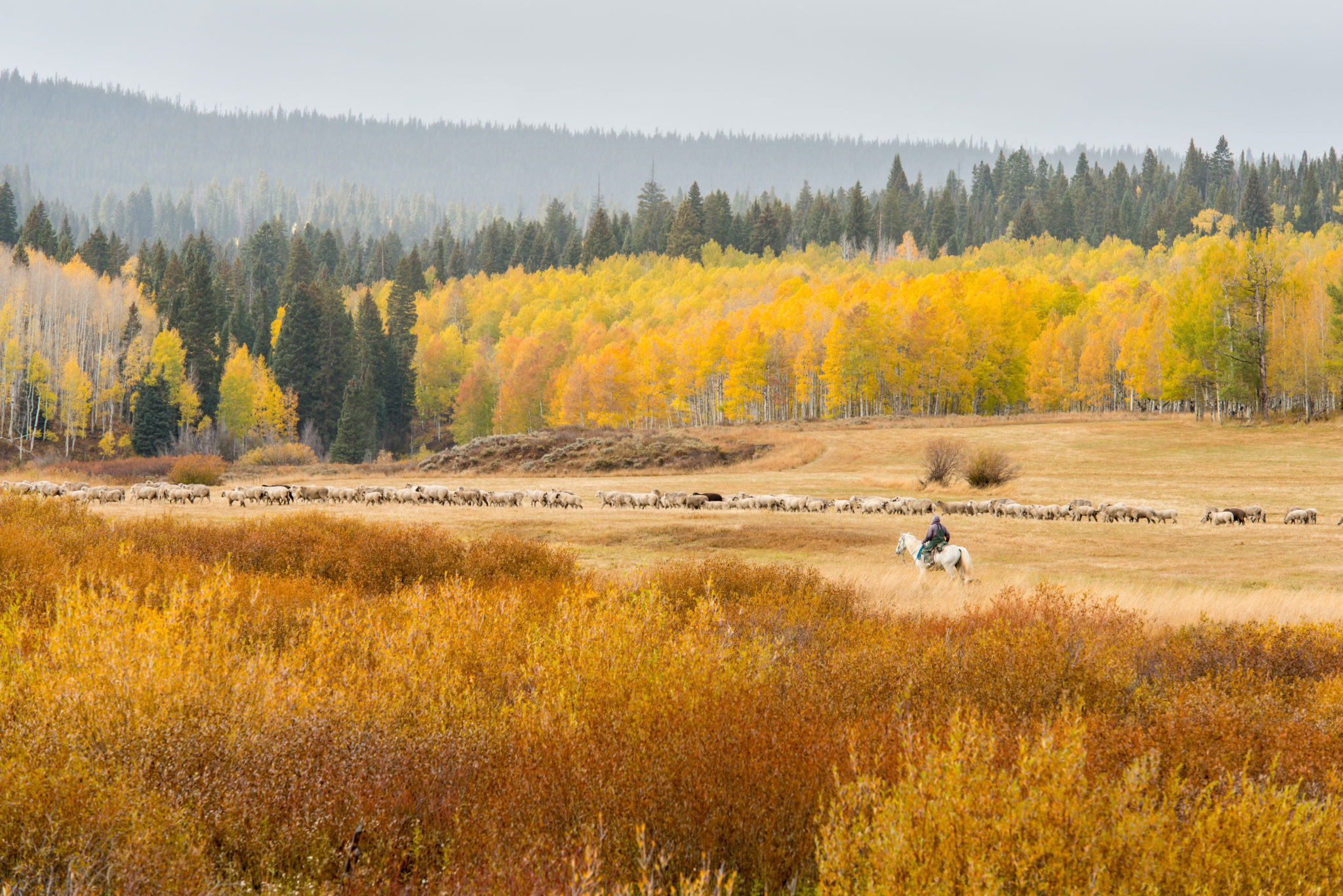
A shepherd moves a flock of sheep in North Park below Rabbit Ears Pass in the Rocky Mountains. Photo: William A. Cotton/CSU
Media contacts:
Jennifer Dimas, Jennifer.dimas@colostate.edu, 970-491-1543
Mary Guiden, mary.guiden@colostate.edu, 970-491-6892
Colorado residents will vote in November 2020 on a ballot initiative that calls for the reintroduction of gray wolves on designated lands west of the continental divide. Since the ballot initiative was approved in early 2020, a pack of wolves was confirmed to be living in Moffat County in the northwestern part of the state. In addition, state Sen. Kerry Donovan introduced a measure concerning the management of gray wolves in Colorado.
Colorado State University’s Center for Human-Carnivore Coexistence was formed in 2019 to better understand how – and if – humans and carnivores can coexist and to develop approaches based on scientific research to reduce conflict. The center’s members include university researchers, agency experts and students.
Recent activities, research
Researchers from the center held a workshop on wolf recovery in early February with representatives from Colorado’s ranching communities, hunter and outfitter groups, environmental non-governmental organizations, sovereign Native American nations, state wildlife agencies and CSU. Read more about the workshop: https://col.st/w4gOu
In addition, these researchers conducted a state-wide survey of more than 700 Coloradans in August 2019 to better understand public beliefs and attitudes related to wolf reintroduction and management. Read the working report: https://col.st/ykkg4
CSU is providing the following list of experts who can address a variety of questions about gray wolf recovery and human-carnivore coexistence. The tip sheet will be updated with new experts periodically and is intended to provide resources to the media but not contact information for the public.
Please note these experts are available to provide impartial scientific information for journalists. As state and federal employees, the researchers neither support nor oppose the current ballot initiative in Colorado.
Large carnivore research, human-carnivore coexistence, economic benefits and impact, community engagement, public agencies and policy change
Stewart Breck, research wildlife biologist with the USDA Wildlife Services’ National Wildlife Research Center and founding member of the Center for Human-Carnivore Coexistence at CSU. Breck specializes in developing and evaluating lethal and non-lethal tools and strategies to help people coexist with large carnivores, research and development of non-lethal tools for wolf management, predation impacts of large carnivores on livestock, and reducing conflict between black bears and coyotes in urban areas.
Kevin Crooks, professor in the Department of Fish, Wildlife and Conservation Biology and director of the new Center for Human-Carnivore Coexistence at CSU. Crooks studies the ecology and conservation of wildlife, often focused on carnivores due to their sensitivity to environmental disturbances. The Center for Human-Carnivore Coexistence is housed within the Warner College of Natural Resources and is focused on integrating transformative science, education and outreach to minimize conflict and facilitate coexistence between people and predators, including wolves in Colorado.
Dana Hoag, professor in Agricultural and Resource Economics. Hoag focuses on the economics of farm and ranch sustainability, especially where tradeoffs occur with the environment or society. He also studies the efficacy and cost of damages from wolves to farmers and ranchers, and their avoidance or mitigation costs, the economic benefits of wolves and the efficacy and economic impact of various government policies.
Becky Niemiec, assistant professor in the Department of Human Dimensions of Natural Resources. Niemiec is a social scientist who studies community outreach and engagement for natural resource management issues. She looks at public and stakeholder perspectives towards wolf reintroduction and management, studying stakeholder engagement processes to make decisions about wolf reintroduction and management and understanding and reducing social conflict over managing carnivores.
Jonathan Salerno, assistant professor in the Department of Human Dimensions of Natural Resources. Salerno is an ecologist studying how people and communities interact with wildlife, and what these interactions mean for livelihoods and wildlife conservation. In terms of the specific issue of wolf reintroduction in Colorado, he focuses how livestock owners communicate and collaborate in response to risks posed by large carnivores.
John Sanderson, director of the Center for Collaborative Conservation at CSU, which helps create innovative and lasting conservation solutions for people and nature through collaboration. Sanderson’s work focuses on the production and use of science in applied contexts, including managing scientific uncertainty. He also studies processes for managing disagreement and finding common ground.
Courtney Schultz, associate professor of natural resource policy in the Department of Forest and Rangeland Stewardship and director of the Public Lands Policy Group. Schultz’s work focuses on how public agencies manage policy change and conduct effective planning for wildlife conservation. She also studies policy tools for wildlife conservation and is well-versed in what policymakers have learned from past carnivore reintroduction efforts.
Tara Teel, professor in the Department of Human Dimensions of Natural Resources. Teel focuses on the use of social science research to inform conservation planning and decision-making, understanding human-wildlife relationships and interactions in the U.S. and globally. She also studies human values toward wildlife, attitudes and behaviors toward wildlife-related issues and social factors underlying human-wildlife conflict.